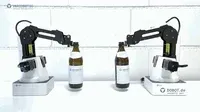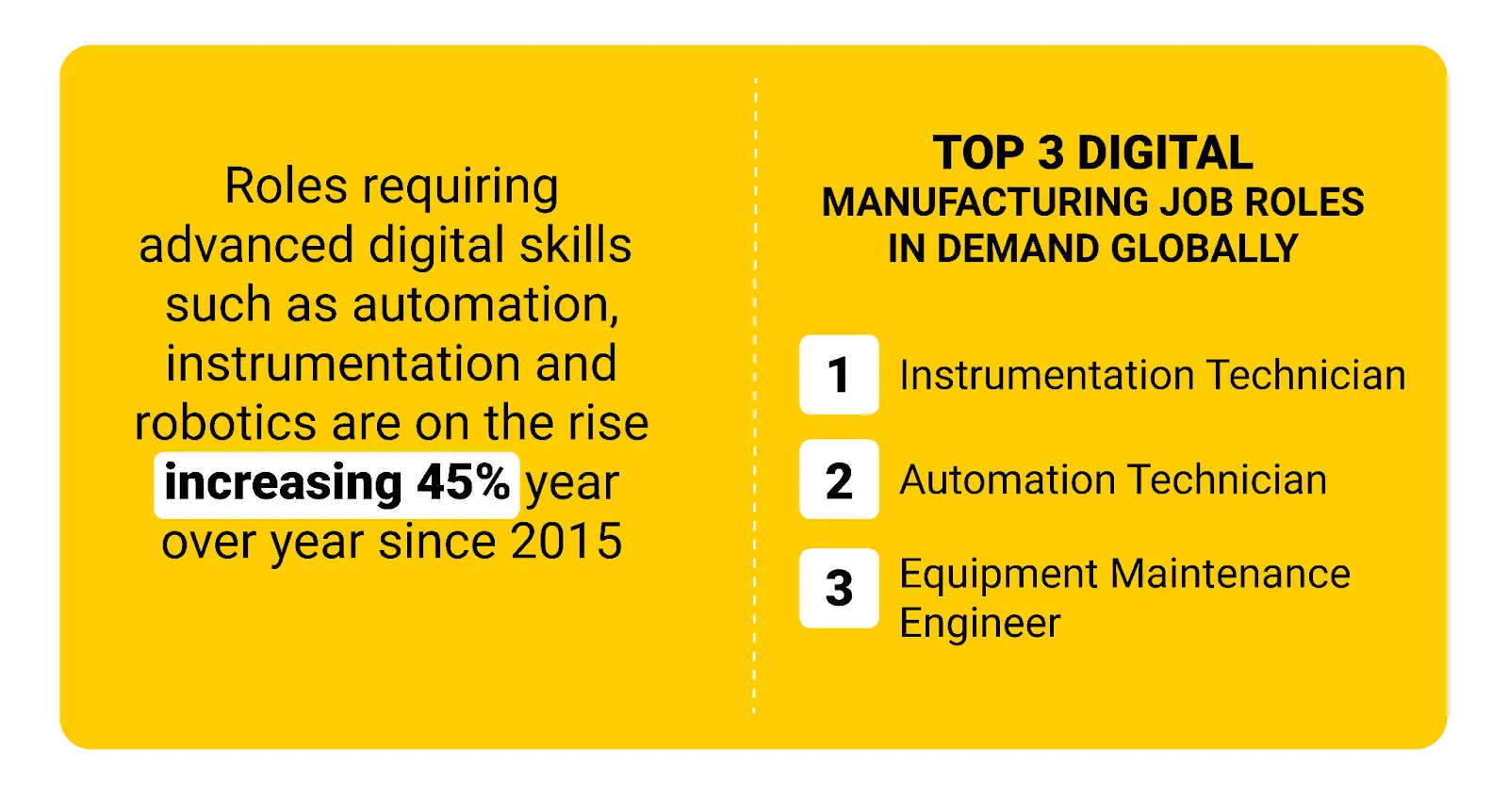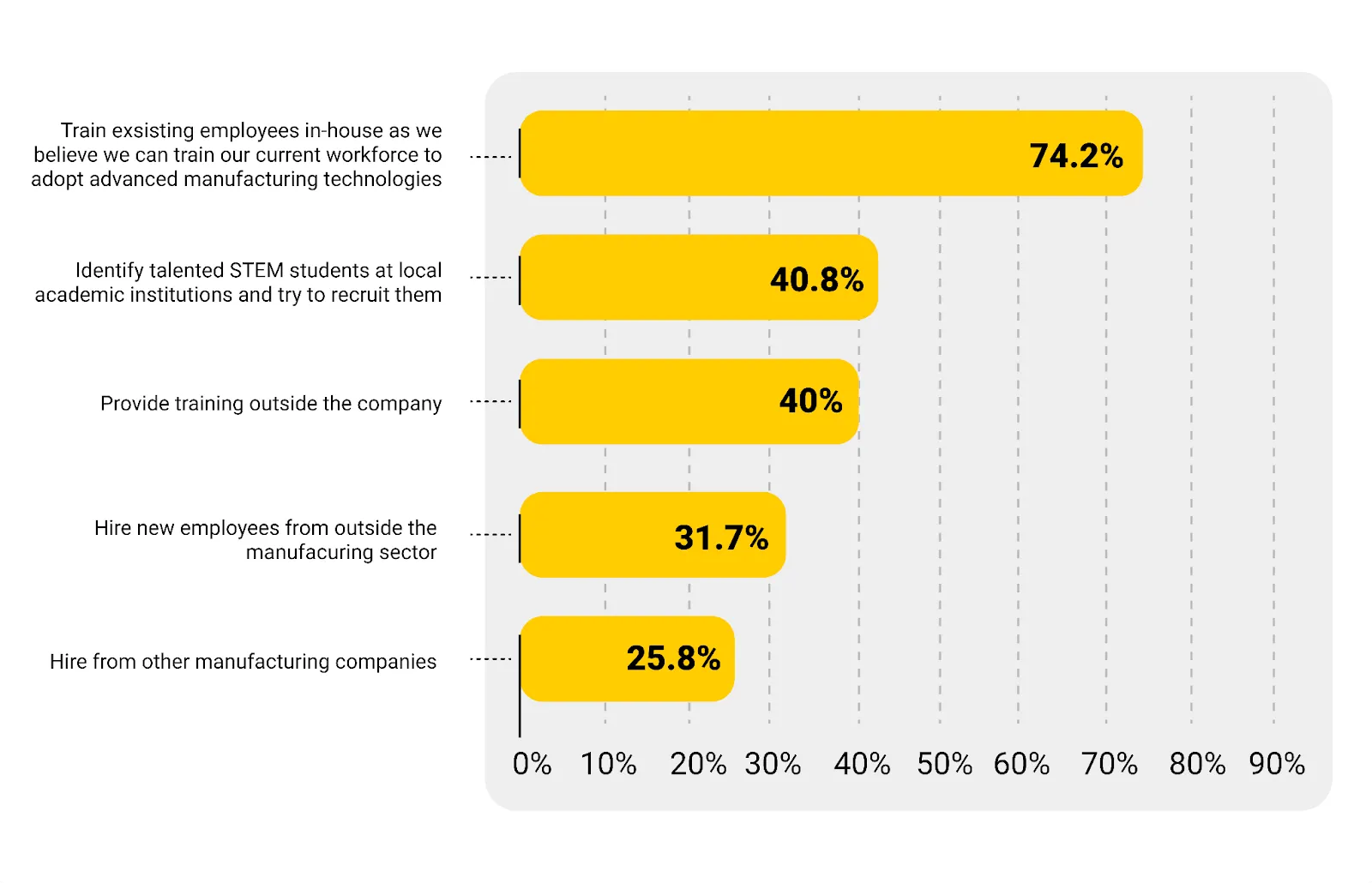The manufacturing industry is struggling with a blue-collar drought. Indeed, hiring challenges seem insurmountable. With roles becoming increasingly technical and demanding, fewer people are choosing to pursue education and training in sectors like manufacturing.
Is your company feeling the crunch?
The salary in the manufacturing sector is a good deal, and the future of the manufacturing industry is brighter than ever. Yet, HR can't entice people, especially the younger generation, to join the industry.

Hiring Challenges in Recruiting a Skilled Workforce in Manufacturing
1. It's an image problem.
"Boring, outdated, and not creative". Working in the manufacturing industry has a negative connotation for many individuals. In a Deloitte survey, 45% of respondents cited "negative perceptions towards the manufacturing industry" as a cause for projected job vacancies. Imagine the HR nightmare.
They are working in manufacturing, maybe even less tempting if you're a woman, as it is still a male-dominated business. According to global research by the World Economic Forum, women make up barely 20% of the manufacturing and industrial workforce.
According to Deloitte, the potential economic impact is considerable, with unfilled positions up to $2.5 trillion by 2028 predicted to result in productivity losses. To become more appealing to women and young people, manufacturing businesses must collaborate with industry organizations.
So, how can the industry appeal to young people, who are the industry's future? Inclusion and environmental and social awareness are significantly more vital to this age group than prior generations. To attract younger generations, manufacturing businesses must convey well their ideas, organization, and culture. Often starting with a modern, collaborative digital environment. A key choice for these companies is deciding between platforms like Google workspace vs Microsoft 365 to support the flexible, tech-savvy work style young talent expects.
Apprenticeships, in which young people learn skills and experience through on-the-job training and participate in local trade-based education, are one way to provide young people with a path into a manufacturing career. However, to attract the brightest young people, the industry's image must improve.
2. The impact of automation and robotization.

Historically, there has always been a fear that new technology will mean fewer jobs.

The reality? New technologies create different opportunities.
According to a Deloitte study, when automation is implemented correctly, it may boost productivity, employee engagement, and consumer value. Amazon was featured in the paper as an example of how a corporation may use automation to increase storage and quickly transport goods during peak periods while decreasing employee training time.
The utilization of automation and robotization should be at the heart of upgrading the industrial industry's image. As technology improves, you may expect to see the types of roles you recruit for change and require various talents.
3. An aging and retiring workforce.

One of the reasons the sector faces a shortage of workers is the high number of recently retired or approaching retirement age. But older workers should be viewed positively. The Organization for Economic Cooperation and Development reported that in the eurozone, workers aged 55-74 accounted for 85% of employment growth between 2012 and 2018.
4. The need for manufacturers to upskill.
According to the World Economic Forum, 54% of all employees will need to be upskilled by 2025 to prepare for the increase in automation and artificial intelligence (AI). Workers will abandon technical tasks to develop skills robots cannot perform, such as critical thinking, problem-solving, and creativity. (So much for the robot uprising, huh?)

Upskilling your workforce is essential to overcome the skills gap. Despite this, most manufacturers do not engage in upskilling or education to help retain employees.
In fact, according to the Tooling U-recent SME poll, "The True Cost of Turnover," only 36% of manufacturing companies pay for employee development, even though two out of every five enterprises have a yearly staff turnover of at least 20%. So, what can you do to overcome these obstacles?
It's critical to make the most of your flexible staff. Be in charge of the things you can affect and put your firm in the best position for the future by designing a strategy to take full advantage of flexible and contingent talent.
Closing the skills gap is very important, with so many manufacturing workers fearing their skills will become obsolete in the next five years.
1. Employee retention.
A recent survey showed that only 36% of manufacturing companies budget for employee development, yet two in five companies have an annual staff turnover of at least 20%.
2. The impact of political and socio-economic change.
The COVID-19 dilemma is one of the most significant challenges the industrial sector has faced in recent memory. Companies have been pushed to discover new working methods to fulfill demand and continue in business, all while dealing with enormous HR difficulties and attempting to keep their employees safe.

Unavoidable layoffs and sick leave have demanded a new approach to recruiting, with the growing contingent workforce proving to be a vital source of talent for many businesses.
A shortage of skilled workers can be a difficulty for any HR manager. It's critical to explore how you might be more imaginative when building your recruitment strategy, especially contingent personnel. Implementing HRIS solutions for growing teams can help manufacturers streamline hiring, centralize workforce data, and manage recruitment and training more efficiently. Tools like Agendrix simplify scheduling and workforce management, while HRIS systems enhance transparency around pay, benefits, and career growth, key factors in retaining skilled workers in a competitive market. So what can you do to combat these challenges? Hire the right people!
Talent Acquisition in the Manufacturing Industry
It is challenging to find employees with the exact skills and qualities you want for specific roles, but you must exert your best effort since choosing the best hires is critical to your company's ongoing success.
HR must find creative ways to recruit manufacturing employees. The following is a guide for acquiring the best talent in the manufacturing industry.
1. Create compelling job descriptions.

Writing an attention-grabbing and thorough job description is one of the most critical parts of the hiring process. Working in manufacturing can be exciting and provide an ideal work environment for work-life balance and career advancement. Make potential employees excited with a description of day-to-day activities in which they can use their soft and hard skills.
2. Look internally.

Before seeking qualified candidates outside your organization, consider if any current employees are looking for a change or promotion and might make a good fit.
Not only do you already know this person's strengths and experience, but because they know the manufacturing world, they do not need as much training and background knowledge as a new hire.
Besides, you may be retaining an employee who otherwise might leave your organization to pursue a similar position elsewhere. Reducing employee turnover helps attract promising talents. Job candidates are attracted to workplaces with a track record of employee longevity.
3. Help employees become brand ambassadors.
There are no better brand ambassadors other than the employees themselves. Have employees speak about how they love their work and how exciting the new applied technologies are. This fuels the interest of jobseekers. And the job seekers lured by this type of strategy take a short period of adjustment and are usually the best performers.
4. Consider new job seekers.
There's no reason not to consider candidates fresh out of school or looking to make a career change. If a job seeker possesses the soft skills and personality traits you're looking for, go ahead.
Give the candidate and yourself a chance. You might discover gold. Just because someone doesn't have a great deal of experience in the manufacturing field doesn't mean they won't make a great employee.
Never underestimate the power of a motivated individual who is eager to learn.
5. Use social media.

Social networks are excellent platforms to get the word out about open positions. If you use these channels, answer questions from interested jobseekers. Encourage sharing.
The more people share your post, the wider the audience is. The more job seekers become aware of your vacancy. You may include photos and videos to help generate excitement.
Best Trend in Talent Acquisition in the Manufacturing Industry: Job Fit
A candidate's job fit is determined by their hard and soft skills, strengths, experience, and needs related to the position in question. It considers the job criteria, work environment, and values to determine whether or not a candidate is a suitable fit.
Job fit also considers whether a worker will develop relationships at your firm to keep them motivated and productive. The premise is that no matter how qualified or experienced a candidate is, if they can't establish constructive team relationships, they're unlikely to have stellar performance.
Because job fit requirements can be so broad, many elements can affect an eventual hiring choice in addition to the skills and knowledge required for the job. Certain personality qualities, for example, can predict whether a candidate will be satisfied or bored if they are hired for a specific role.
Other criteria, such as a candidate's assertiveness, are good predictors of a candidate's suitability for managerial positions.
What is the most challenging aspect of determining job fit? Before making a job offer, ensure you get the correct information about your candidates and evaluate them using relevant, job-related criteria.
How to Assess the Job Fit?

Consider the following:
- Cultural fit: will the organization's culture match the applicant's needs to succeed in a particular work environment?
- Values, beliefs, outlook: Does the employee share the prevailing values of his organization and its workforce?
- Experience: Does the candidate have the work and life experience necessary to excel in the job? Does it matter?
- Education and Training: Does your candidate have the proper education and training for the job? Can she obtain it on time? Or, does your organization have the confidence and expertise to provide it?
ALSO READ - How to Connect with C-Level Executives: An SDR's Guide
The Final Note
When it comes to finding and hiring great people that will fit in well with your job description, you have to be patient, persistent, and creative. Optimizing your flexible workforce is essential.
Take control of the factors you can influence. Develop a strategy to take full advantage of flexible and contingent talent. The manufacturing industry's future is beckoning brightly!
Let Ai-Bees aid you in putting your company in the best position for the future. Together, let us begin your journey to success! Please drop us a call. We will be glad to be of service.
Make Loss Impossible
with Performance-Based Marketing

Personalized Campaigns with
Precisely Selected Prospects
.svg)
Analysis From Your Dedicated
Account Manager

with a Team of Growth Hackers
we Develop your Tailor-Made Strategy

.svg)











%201.svg)
.svg)





.webp)